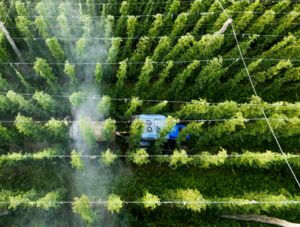Testing, testing: the need for constant vigilance on pesticide food residues

Although pesticide use on food products continues to cause concern on environmental and safety grounds, insecticides and herbicides will nevertheless play key roles in guaranteeing global food security for years to come. Since pesticides are intrinsically toxic, laboratory testing of pesticide residues in food will be vital in ensuring that goods do not exceed maximum residue limits for pesticides (MRLs) and are safe to eat. But for food free from pesticide contamination to become a reality, continuous vigilance will be required to protect consumers from banned and unauthorised pesticides, a lack of good agricultural practice (GAP), and the dangers posed by differences in pesticide regulations between nations.
Introduction
Despite worries about the effects of pesticide exposure on humans and the environment, the chemicals are expected to play a key role in the agriculture of the future, as the world gets to grips with rapid population growth. By 2050, there are expected to be 9.7 billion people on Earth – 30% more than in 2017 – and feeding them all will depend on “either increases in yields and/or the number of times each year crops can be grown on the same land.” As one study puts it, this "continuous development of agriculture intensifies the application of pesticides globally to reduce crop yield losses and increase productivity and product quality.”
Taming toxic pesticides
As the World Health Organisation (WHO) explains, “pesticides are intrinsically toxic”, and “can have both acute and chronic health effects, depending on the quantity and ways in which a person is exposed.” Just how toxic a pesticide is depends on various factors: for example, insecticides tend to be more harmful to humans than herbicides, and individual chemicals can have different effects depending on how much of them people are exposed to, as well as how they are exposed. Those at greatest risk from pesticides often come into contact with them at work – a study published in npj Parkinson’s disease recently suggested that people exposed to agricultural chemicals exhibited genetic variations that “may generate an underlying susceptibility for developing (Parkinson’s) with pesticide exposure.” Meanwhile, more than a third of Asian farmers interviewed for a study last year said they had experienced symptoms of illness after pesticide exposure – including dizziness, headache, excessive sweating, vomiting, blurred vision and skin rashes. Those living close to fields treated with chemicals are also considered to be at risk: a US teaching union is currently suing regulators for allegedly disregarding children’s health in allowing farms to use restricted pesticides close to three California schools. As well as currently used pesticides, banned and hazardous older chemicals such as the carcinogens dichlorodiphenyltrichloroethane (DDT) and γ-HCH (lindane) can also remain in soil and water for years after they were last used.
Addressing these concerns, WHO states that “None of the pesticides currently authorized for use on food in international trade are genotoxic”, and that adverse effects only occur if they are used in unsafe ways. It also points out that the general population of the world is “exposed to significantly lower levels of pesticide residues through food and water.” WHO’s two main objectives are therefore (a) “to ban the pesticides that are most toxic to humans, as well as pesticides that remain for the longest time in the environment”, and (b) “to protect public health by setting maximum limits for pesticide residues in food and water.”
Food safety, and the lack of harmonisation in global pesticide regulations

WHO also declares that “Food that is sold or donated.... should comply with pesticide regulations, in particular with maximum residue limits”, while “use of pesticides to produce food, both to feed local populations and for export, should comply with good agricultural practices regardless of the economic status of a country.” Therefore farmers “should limit the amount of pesticide used to the minimum necessary to protect their crops”.
These aspirations are not always being met in practice, however. While global standards on safe, maximum pesticide residues for foods and feeds (widely known as MRLs) have been agreed, and promulgated by the Codex Alimentarius Commission, real-world “pesticide MRLs in foods and feeds significantly differ, especially among developed and developing countries”. Not only do first-world countries – such as European Union (EU) member states - tend to adopt more stringent MRLs, but farmers in many developing countries also continue to use pesticides that have been banned in markets like the EU and US due to health concerns. For example, the organophosphate insecticide chlorpyrifos is now largely banned in Europe and North America, but “is still being applied in China, India, and many other countries of the Global South.” A Belgrade University study pointed out last year that around a third of the 475 new pesticides recently approved in Brazil – South America’s largest user of pesticides – “contain active substances that have been banned or restricted in the EU”, while Kenya has registered 51 active ingredients prohibited in Europe. Meanwhile a report from Pesticide Action Network Asia Pacific (PANAP) on pesticide use in selected farming communities in India, Bangladesh, Vietnam and Laos found that the “majority of pesticides being used... are considered as Highly Hazardous Pesticides (HHPs) or banned in one or more countries.” Another study published in the journal Environmental Research detected chlorpyrifos and chlorpropham (the latter banned in the EU and largely restricted in the US) in ‘most’ of the cereal, vegetable, fruit, and animal-based foods samples it sourced from markets in two Indian cities. Finally, the Endocrine Society said this year that “illegal agricultural use (of DDT) may still be occurring in some countries such as India, Ethiopia, and Ghana”, despite being prohibited under the Stockholm Convention.
As the Belgrade University study argues, differences in pesticide uses and regulations not only cause trade issues between nations, but pose significant health risks to food consumers. This is because “food containing residues of banned pesticides is frequently reimported back to the countries that allow their production and export, contributing to a global pesticide exposure risk.”
Why are pesticides present in our foods?
Analysis from the European Food Safety Agency (EFSA) provides some valuable insights into the types of non-approved pesticides detected in foods exported to the EU, as well as the reasons why some imported foods fail to comply with European MRLs. In a supplementary paper to EFSA’s 2021 European Report on pesticide residues in foods, scientists said residues of unauthorised chlorpyrifos had been detected in oranges from Egypt, grapefruit from Turkey, Chinese tea leaves, Indian sesame seeds and Egyptian grape leaves, while another EU prohibited chemical - propiconazole – had been found in oranges from South Africa. The report also said that some products – including Turkish pomegranates and Pakistani rice – had been rejected because Good Agricultural Practice (GAP) had not been followed for pesticides like acetamiprid, leading to the items exceeding MRLs. Another issue highlighted was the use of prohibited chemicals such as ethylene oxide during the processing of sesame seeds and curcuma (turmeric) from India.
EFSA also reported a number of reasons why food items produced within the EU had failed to meet the bloc’s safety standards, such as:
failing to meet GAP requirements on pesticide application rates
use of authorised pesticides on non-authorised crops
use of non-authorised pesticides, such as chlorfenapyr
contamination by persistent compounds such as heptachlor, chlorate, and HCH
The importance of food testing
The good news – at least for first world consumers - is that rigorous analytical testing appears to be keeping them largely safe from goods that contain banned pesticides or exceed MRLs.
The most recent (2022) EFSA report on pesticide residues in EU food showed that – from a “snapshot” study of 12 food types, including apples, strawberries, oat and barley grain, swine fat, and cow’s milk – only 1.6% of samples exceeded pesticide MRLs. This represented just 192 out of 11,727 items analysed in the snapshot, while the percentage of non-compliant snapshot samples also fell from 2% in 2019. Overall, just 3.7% of 110,829 food samples analysed throughout the EU in 2022 exceeded pesticide MRLs, compared to 3.9% in 2021 – but EFSA also flagged up the fact that food items imported from outside the EU “showed a fourfold higher non-compliance rate (4.5%) compared with food produced within the EU (1%)”, while foods of unknown origin were three times more likely to be non-compliant. EFSA therefore recommended that individual nations should “keep monitoring pesticide residues in samples imported from third countries with a wide analytical scope.”
Keeping a close eye on pesticide residues in imported foods is already a key strand of US Food and Drug Administration (FDA) testing policy – which focuses disproportionately on analysing imported food samples from certain countries, as it believes they are “more likely to contain violative pesticide chemical residues” than US-produced foods. The FDA’s most recent report – the Pesticide Residue Monitoring Report and Data for FY 2021 – found that 96.7% of domestic human foods tested were compliant with federal standards, compared to 89.3% of imports. It also stated that 9% of imported grains, 10.3% of imported fruits, and 11.8 % of imported vegetables were classed as “violative” – a failure rate the FDA said “affirms the validity of the sampling design in targeting import commodities.”
LGC Standards – quality and innovation in food pesticide testing
For almost 50 years, LGC Standards companies have built a worldwide reputation for consistently developing quality pesticide reference materials, research chemicals, and proficiency testing schemes. Globally, we offer almost 6,000 pesticide productsthat help laboratories around the world keep our food and environment safe. More than half are ISO 17034-accredited - and 100% are either accredited to ISO 17034 or produced under our manufacturing sites’ ISO 17025 certifications.
Our commitment to constant innovation inspired our skilled scientists to develop the unique Smart Solutions™ v700 PestiMix Kit – the largest mix of pesticide analytes to be found anywhere on the market. Combining more than 700 analytes for liquid chromatography in only ten ampoules, PestiMix not only greatly reduces the risk of error for laboratories, but additionally removes the need for complicated method development and dilution steps. We’re also proud to have originated the ISO 17034-accredited Smart Solutions™ v400 GC PestiMix Kit to enable the rapid testing of 430 analytes via gas chromatography.
Our wider pesticide portfolio also adapts constantly to reflect ever-changing regulatory demands in an increasingly globalised world – enabling us to launch around 100 new products over the last year for testing pesticides in foods, beverages and the environment, with over half of them ISO 17034-accredited. What’s more, all of our ISO 17034 RMs are supplied with comprehensive Certificates of Analysis - guaranteeing that your product is a completely known quantity and giving you supreme confidence in your results.
The full LGC Standards pesticide products range also features more than 900 research chemicals, which are ideal for studies into pesticides in food and the environment, as well as 30+ proficiency testing samples, featuring a wide range of analytes and matrices.
|
Get more from LGC Standards



